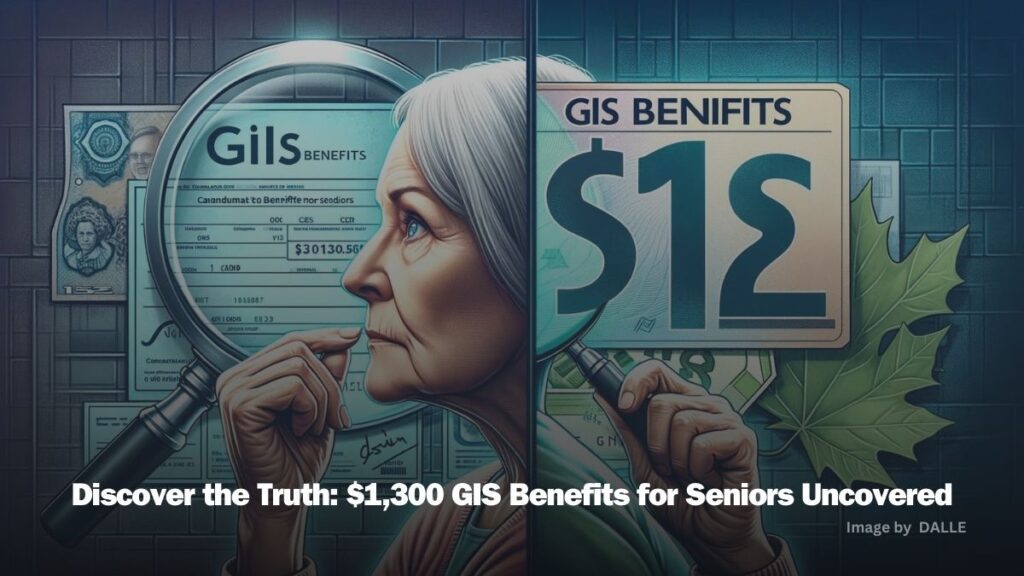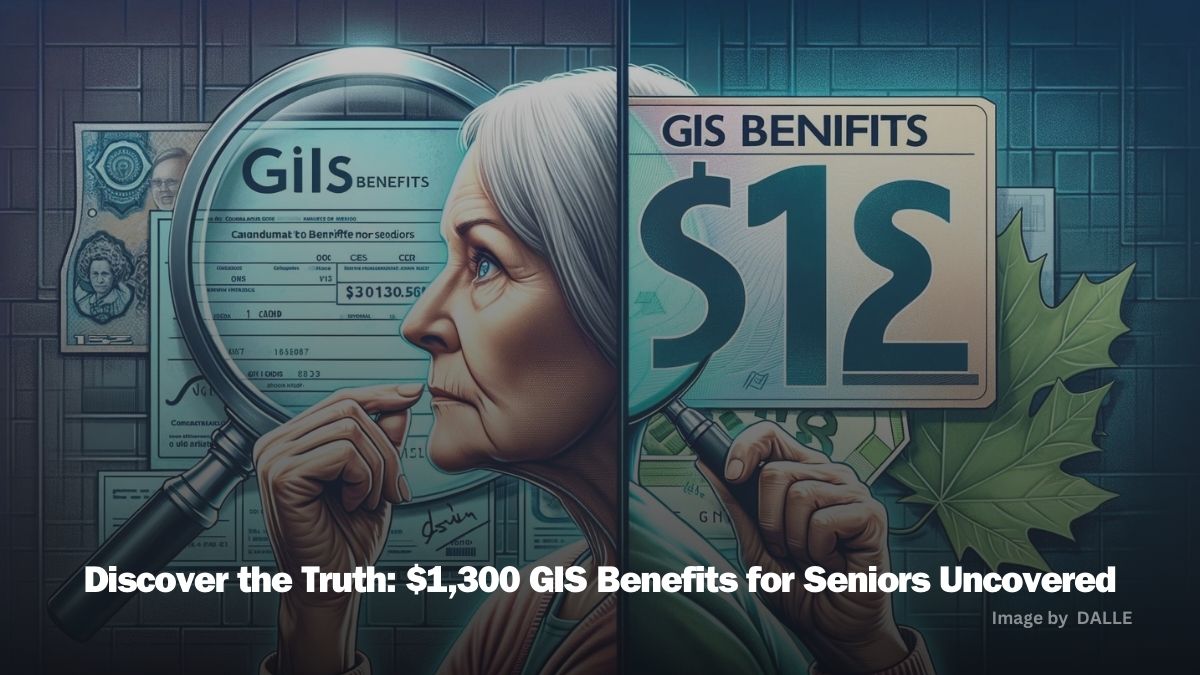Key Takeaway Box
- No government program offers an extra $1,300 monthly benefit to seniors aged 55 and older in Canada.
- The claim is based on a misleading interpretation of a proposal by the Canadian Centre for Policy Alternatives (CCPA) to expand the Guaranteed Income Supplement (GIS) for low-income seniors.
- The proposal has not been adopted by the federal government and is unlikely to be implemented shortly.
- Seniors aged 55 and older may be eligible for other benefits and assistance programs, such as Old Age Security (OAS), Canada Pension Plan (CPP), Allowance, and more.

What is the Extra $1,300 Monthly Benefit Claim?
You may have seen some online ads or articles claiming that seniors aged 55 and older can get an extra $1,300 monthly benefit from the government. The claim is based on a report by the Canadian Centre for Policy Alternatives (CCPA), a progressive think tank, that proposes to expand the Guaranteed Income Supplement (GIS) for low-income seniors.
The GIS is a monthly payment that supplements the Old Age Security (OAS) pension for seniors who have little or no other income. The amount of GIS you receive depends on your marital status, your income, and your spouse’s income. The maximum monthly GIS payment for a single senior is $936.45, and for a couple, it is $1,354.69².
The CCPA report suggests that the GIS should be increased by 50% for seniors aged 65 to 74, and by 100% for seniors aged 75 and older. This would mean that a single senior aged 75 and older could receive up to $1,872.90 per month in GIS, and a couple could receive up to $2,709.38 per month.
The report also proposes to lower the eligibility age for the GIS from 65 to 60, and to introduce a new benefit for seniors aged 55 to 59 who are not working or have low earnings. The new benefit would be equivalent to 50% of the GIS, which would amount to $468.23 per month for a single senior, and $677.35 per month for a couple.
The report claims that these changes would reduce the poverty rate among seniors from 12% to 3%, and would cost about $20 billion per year, or 0.9% of Canada’s GDP.
Is the Extra $1,300 Monthly GIS Benefit Real?
The short answer is no. The CCPA report is not a government policy, but a policy proposal. It has not been adopted by the federal government, nor has it been endorsed by any political party. It is unlikely that the proposal will be implemented in the near future, given the fiscal challenges and competing priorities facing the government.
The claim that seniors aged 55 and older can get an extra $1,300 monthly benefit is based on a misleading interpretation of the CCPA report. The report does not suggest that all seniors aged 55 and older would receive an extra $1,300 per month, but only those who are eligible for the GIS or the proposed new benefit. The amount of the benefit would vary depending on the income and age of the senior, and the maximum amount would be $1,872.90 per month for a single senior aged 75 and older, not $1,300 per month for a senior aged 55 and older.
The claim also ignores the fact that the GIS and the proposed new benefit are income-tested, which means that they are reduced or eliminated if the senior has other sources of income, such as CPP, private pensions, investments, or earnings. For example, a single senior who receives the maximum OAS pension of $626.49 per month would not qualify for any GIS or new benefit if their income from other sources exceeds $18,648 per year².
How to Apply for the GIS and Other Benefits?
If you are a senior aged 60 or older, you may be eligible for the OAS pension, the GIS, and other benefits and assistance programs. To apply for the OAS pension and the GIS, you need to fill out and submit the Application for the OAS and the GIS form. You can also apply online through your My Service Canada Account.
If you are already receiving the OAS pension, you do not need to apply for the GIS. Service Canada will automatically review your income tax return and notify you if you are eligible. However, if you have not filed your income tax return, you should do so as soon as possible, or contact Service Canada to provide your income information.
If you are a senior aged 60 to 64, you may also qualify for the Allowance or the Allowance for the Survivor. The Allowance is a monthly payment for low-income seniors whose spouse or partner receives the OAS pension and the GIS. The Allowance for the Survivor is a monthly payment for low-income seniors who are widowed and have little or no income. The maximum monthly Allowance payment is $1,354.69, and the maximum monthly Allowance for the Survivor payment is $1,436.76².
To apply for the Allowance or the Allowance for the Survivor, you need to fill out and submit the Application for the Allowance or Allowance for the Survivor form. You can also apply online through your My Service Canada Account.
If you are a senior aged 55 to 59, you are not eligible for the OAS pension, the GIS, or the Allowance. However, you may be eligible for other benefits and assistance programs, such as:
- The Canada Pension Plan (CPP), which provides a monthly retirement pension to eligible workers who have contributed to the plan. You can apply for the CPP retirement pension as early as age 60, but your monthly payment will be reduced by 0.6% for each month that you start receiving it before age 65. The maximum monthly CPP retirement pension for 2024 is $1,203.75⁵. To apply for the CPP retirement pension, you need to fill out and submit the [Application for a Canada Pension Plan Retirement Pension] form. You can also apply online through your My Service Canada Account.
- The Canada Workers Benefit (CWB), which is a refundable tax credit that supplements the earnings of low-income workers. You can claim the CWB when you file your income tax return. The maximum annual CWB amount for 2024 is $1,395 for single individuals, and $2,403 for families.
- The Goods and Services Tax/Harmonized Sales Tax (GST/HST) Credit, which is a tax-free quarterly payment that helps offset the GST or HST that you pay on goods and services. You can apply for the GST/HST credit when you file your income tax return. The maximum annual GST/HST credit amount for 2024 is $456 for single individuals, and $598 for couples.
- The Disability Tax Credit (DTC), which is a non-refundable tax credit that reduces the amount of income tax that you have to pay if you have a severe and prolonged impairment in physical or mental functions. You can apply for the DTC by filling out and submitting the [Form T2201, Disability Tax Credit Certificate]. The DTC amount for 2024 is $8,662.
- The Canada Caregiver Credit (CCC), which is a non-refundable tax credit that helps you reduce the amount of income tax that you have to pay if you support a spouse, partner, or a dependent with a physical or mental impairment. You can claim the CCC when you file your income tax return. The CCC amount for 2024 is $7,276 for a spouse or partner, and $2,273 for a dependent.
IMPORTANT LINKS:
- What Expenses Can You Deduct from Your Rental Income? (Updated 2024)
- How to Get Your EITC Refund Faster in 2024
- CPP, RRSP, TFSA, FHSA, AMT and OAS Changes: What You Need to Know for 2024
- What Happens to Your CPP and OAS Benefits When Your Spouse Dies?
- How to Get the Grocery Rebate Payments in Canada in January 2024
Fact Check: Is the Extra $1,300 Monthly Benefit Real?
The claim that seniors aged 55 and older can get an extra $1,300 monthly benefit from the government is false. It is based on a misleading interpretation of a policy proposal by the CCPA that has not been adopted by the government and is unlikely to be implemented in the near future. The proposal suggests to increase the GIS and lower the eligibility age, but not to give all seniors an extra $1,300 per month. The amount of the benefit would depend on the income and age of the senior, and the maximum amount would be $1,872.90 per month for a single senior aged 75 and older.
Seniors aged 55 and older may be eligible for other benefits and assistance programs, such as OAS, CPP, Allowance, CWB, GST/HST credit, DTC, and CCC. To apply for these benefits and programs, you need to fill out and submit the appropriate forms, or apply online through your My Service Canada Account. You also need to file your income tax return every year to ensure that you receive the benefits that you are entitled to.














